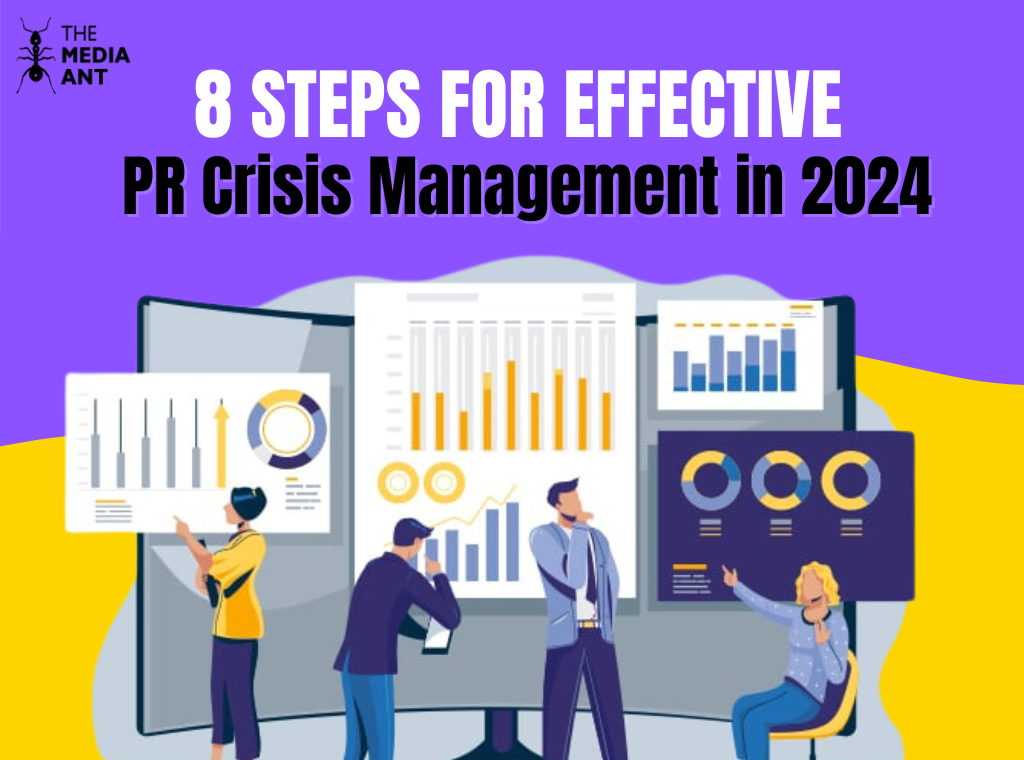In order to effectively manage the PR crisis in 2024 and beyond, organizations need to take a proactive and adaptable approach. The digital landscape and consumer expectations are constantly evolving, and global markets are interconnected like never before. With news spreading rapidly on social media and misinformation causing crises in an instant, it’s crucial for businesses to be well-prepared and able to navigate challenges swiftly.
By following a structured approach consisting of eight key steps, organizations can not only minimize the impact of crises but also come out stronger and more resilient. These steps include strategic planning, transparent communication, quick response, and continuous evaluation, all of which are essential in today’s digital age. Let’s take a closer look at these steps and how they can help organizations effectively manage PR crises.
What is Public Relations Crisis Management?
Crisis Management in Public Relations involves the strategic handling of negative events that could harm an organization’s reputation. It requires quick and effective communication to address the crisis, minimize damage, and rebuild public trust. Key elements include risk identification, response planning, and communication strategies to manage the impact on stakeholders such as customers, employees, investors, and the media. Successful crisis management entails transparency, honesty, empathy, and proactive measures to prevent future incidents. Through prompt and decisive action, organizations can successfully navigate crises, safeguard their reputation, and emerge stronger.
When should you react to PR crises?
Reacting promptly to PR crises is essential to minimize potential harm to your brand’s reputation. Here is a general guideline on when to respond:
- Immediate Response:
Some PR crises require an immediate reaction, especially if they endanger public safety, involve illegal activities, or are rapidly spreading on social media. Examples include safety-related product recalls, allegations of misconduct, or situations where the public is at risk.
- Response Within Hours:
For less urgent PR crises that still demand quick attention, aim to reply within hours. This time frame is suitable for addressing issues like negative viral campaigns, customer complaints gaining momentum on social media, or unexpected events that could tarnish your brand’s image.
- Response Within 24 Hours:
Even if the crisis does not demand an immediate reply, it is generally recommended to address it within 24 hours. This allows you to gather information, evaluate the situation, and formulate a thoughtful and effective response. Delaying too long can lead to speculation and further harm to your brand’s reputation.
- Confirmation of Facts:
It is crucial to react based on verified information rather than rumors or assumptions. Once you have confirmed the facts related to the crisis, you can respond confidently and transparently, which aids in rebuilding trust with your audience.
- Continuous Monitoring:
PR crises often develop over time, so it is vital to closely monitor the situation and adjust your response strategy accordingly. Provide regular updates to stakeholders and the public as new details emerge, showcasing your dedication to transparency and accountability.
Ultimately, the timing of your response to a PR crisis should prioritize swift action while maintaining accuracy and thoughtful consideration of the circumstances. Since each crisis is unique, it is important to assess the situation and tailor your response accordingly.
How to handle a PR crisis – 8 steps
Certainly, effectively managing a PR crisis necessitates a strategic approach. Here are eight steps to assist you in navigating the process:
1. Assemble the Team and Evaluate the Situation
- Gather essential stakeholders, including PR professionals, legal advisors, senior management, and relevant department heads.
- Conduct a thorough analysis of the situation to determine the crisis’s magnitude, potential risks, and impacts, as well as its root cause. Consider both internal and external factors that influence the situation.
2. Embrace Transparency and Acknowledge Responsibility
- Transparency is crucial. Openly and honestly acknowledge the crisis, avoiding downplaying its severity or shifting blame.
- Take responsibility for any mistakes or shortcomings that contributed to the crisis. Demonstrating accountability can aid in rebuilding trust with stakeholders.
3. Develop a Clear and Consistent Message
- Create a unified message that aligns with your brand values. Ensure that all communications, both internal and external, accurately convey this message.
- Tailor your messaging to suit different communication channels, such as press releases, social media, and direct communications with stakeholders.
4. React Promptly, but Strategically
- Respond swiftly to the crisis to prevent further escalation. However, ensure that your actions are well-considered and aligned with your overall strategy.
- Prioritize accuracy over speed. While it is important to act quickly, verifying information before disseminating it is crucial to avoid spreading misinformation.
5. Take Action to Resolve the Situation:
- Implement practical solutions to address the underlying issues that caused the crisis. This may involve actions such as product recalls, policy changes, or organizational reforms.
- Communicate the steps you are taking to rectify the situation to keep stakeholders informed. Transparency about your efforts to resolve the crisis can help rebuild trust.
6. Engage with Your Audience:
- Monitor social media and other channels to listen and respond to feedback and concerns from your audience. Engage in two-way communication to address questions and alleviate concerns.
- Show empathy and understanding towards those affected by the crisis. Expressing genuine concern can help mitigate negative sentiment.
7. Utilize the Power of Earned Media:
- Seek opportunities to gain positive coverage from credible media outlets or influencers. Highlight any positive actions or initiatives undertaken in response to the crisis.
- Leverage third-party endorsements to enhance your reputation and rebuild trust.
8. Learn From the Crisis and Enhance:
- Conduct a thorough analysis after the crisis has subsided to evaluate your response. Identify areas for improvement and use the lessons learned to strengthen your crisis management processes for the future.
By following these steps, you can effectively navigate a PR crisis, safeguard your brand’s reputation, and rebuild trust with stakeholders.
PR crisis management tools
Crisis Plan
A crisis plan is an essential tool that you should have in place. It’s a document that outlines your goals, strategies, roles, and procedures for dealing with a crisis. To make sure it’s effective, your crisis plan should be based on a thorough risk assessment and cover different scenarios, audiences, messages, and channels. Remember to update it regularly, test it periodically, and communicate it clearly to your team and partners.
Crisis Team
Another important tool is a crisis team. This is a group of people who will be responsible for implementing your crisis plan and coordinating your actions. Your crisis team should include representatives from different departments like PR, legal, operations, and customer service. It’s crucial to have a designated leader, spokesperson, and contact person within the team. Make sure everyone knows their roles and responsibilities and encourage frequent and effective communication within the team.
Media Monitoring
Media monitoring is also a vital tool to have during a crisis. It involves tracking and analyzing the media coverage and public sentiment about your organization and the crisis you’re facing. By monitoring the media, you can identify the sources, trends, and issues that may impact your reputation. It also helps you measure the effectiveness of your crisis communication efforts. There are various tools you can use for media monitoring, such as online platforms, social media, surveys, and focus groups.
Conclusion
In the fast-paced digital world, companies must handle PR crisis effectively. By following eight key steps, businesses can navigate tough times with flexibility and honesty, protecting their image and maintaining trust with stakeholders. Through open communication, proactive strategies, and ongoing education, companies can turn crisis into opportunities for growth.
By focusing on readiness, truthfulness, and quick responses, businesses can emerge stronger, demonstrating their dedication to quality and responsibility to the public. Explore the evolving role of advertising in PR Communication Age Magazine. Discover innovative strategies to integrate advertising effectively amidst PR crisis management challenges. Stay ahead in brand reputation management
FAQs on PR Crisis Management
1. What are the 5Ps of crisis management?
The 5Ps of crisis management are:
1. Preparation: Establishing plans, protocols, and resources in advance to effectively respond to crises.
2. Prevention: Identifying potential risks and implementing measures to mitigate them before they escalate into crises.
3. Prediction: Anticipating potential crises through monitoring, analysis, and risk assessment.
4. Proaction: Taking proactive steps to address issues and prevent them from developing into a full-blown crisis.
5. Post-action: Conducting post-crisis evaluations, learning from the experience, and implementing improvements for future crisis management.
2. What is the first rule of PR?
The first rule of PR is often summarized as “Tell the truth.” Transparency and honesty are fundamental principles in public relations. Maintaining credibility and trustworthiness with stakeholders requires being truthful and forthcoming, especially during challenging situations like crises.
3. How can companies effectively monitor and detect PR crises in the digital age?
Companies can effectively monitor and detect PR crises in the digital age by:
1. Utilizing social media monitoring tools to track mentions, sentiment, and trends related to their brand.
2. up Google Alerts or other similar services to receive notifications about brand mentions or relevant keywords.
3. Actively engaging with customers and followers on social media to address concerns and identify emerging issues.
4. Monitoring news websites, forums, review platforms, and other online channels where discussions about the brand may occur.
5. Establishing clear escalation protocols and processes for handling potential crises as they arise.
4. What causes the PR crisis?
PR crises can be caused by a variety of factors, including:
1. Product defects or safety issues
2. Misconduct or unethical behavior by company executives or employees
3. Negative publicity or backlash related to company actions or decisions
4. Social media controversies or viral campaigns
5. Legal issues or regulatory violations
6. Customer complaints or dissatisfaction with products or services
7. Environmental or corporate social responsibility (CSR) failures
5. What is bad PR?
Bad PR refers to negative publicity or public relations outcomes that harm a company’s reputation or image. It can result from various factors, including mishandling of crises, inappropriate responses to media inquiries, negative coverage in the press, social media backlash, or scandals involving company personnel or practices. Bad PR can have significant consequences for a company, including loss of customers, damage to brand reputation, and financial repercussions.





